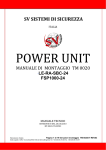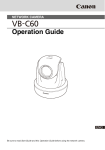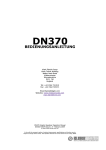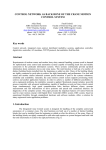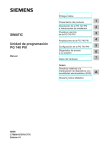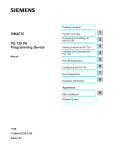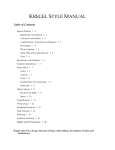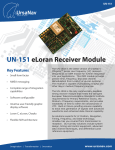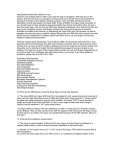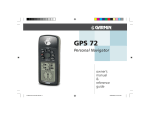Download IV. Receiver Features and Their Use
Transcript
CHAPTER IV
Receiver Features
and Their Use
Introduction
Earlierchapters have addressed the theory of
the Loran-C system. This chapter narrows the
focus to the shipboard component of the system-Loran-Creceivers. Specifically,this chapter provides an overview of the key features and
characteristics of Loran-C receivers relevant to
thenavigator. Readers wishing to learn about the
operating instructions for a specific make and
model of loran receiver are advised to consult
the appropriate owner's manual for details. As
of this writing, there are at least 25 brand names
of marine Loran-C units, (and several manufacturers of aircraft lorans)' and most manufacturers produce several models-so the user has a
wide array of choices. Available Loran-C receivers differ substantially in design, type of
displays, and operating instructions, making it
impractical to cover this information in requisite
depth in a chapter of reasonable length. Moreover, any such discussion would rapidly become
obsolete because new models are continually
being introduced.
This chapter serves as a supplement to the
owner's manual, providing perspective, rationale, and theory to explain the features of modern Loran-C receivers. Prospective purchasers
of a loran receiver may also find this chapter
useful to identify the potentially desirable features of loran sets. Readers should be aware,
however, that neither the Coast Guard nor any
other agency of the U.S. government has the
responsibility of performance evaluation orpublication of comparativeperformance statisticsof
recreational vessel loran receivers although
marine lorans used on certain types of vessels
and aircraft lorans must meet technical performance criteria. (There are private sector publications that do preselAt.technical data and frank
evaluations of Loran-C receivers.) It is also
worth reminding the reader that receiver photo-
'Some of these are undoubtedly made by the same manufacturers, with only minor changes in the
size or shape of housing or other "cosmetic" differences to distinguish "private label."
IV-1
IV-2
Loran-C User Handbook
graphs included in this handbook are for illustra- tions," is simply not good advice when it comes
tive purposes only and should not be construed to today's sophisticated marine electronics or
asendorsementsof any particular make or model. avionics. There is no substitute for careful study
of the owner's manual.
As with this handbook generally, the focus
of this chapter is on marine users. Where approOwner's manuals differ significantly in the
priate, supplemental material relevant to other amount of detail presented, and in their clarity
users is included.
and accuracy. The prospective purchaser is well
advised to read this document and include the
Read Your Owner's Manual
quality of the manual among the attributes to be
Although all' Loran-C receivers operate on considered in the purchase decision.
the same general principles, there are important
differences among these receivers in features,
The old saw: "when all else fails, read the
methods of operation, and even in the defini tions
directions,'' is simply not good advice when
of terms used in the operating instructions. For
it comes to today's sophisticated marine
example, one manufacturer uses the term "veelectronics. There is no substitute for carelocity along route" (VAR) to describe the comful study of the owner's manual.
ponent of the aircraft's or ship's speed over the
ground in the direction of the course (more
below), while other manufacturers use terms Generations of Loran-C Receivers
such as "velocity made good" (VMG) or "speed
Although the earliest Loran-Creceivers were
of advance" (SOA) to describe the same term. a substantial improvement over Loran-A receivAs a second example, one manufacturer calcu- ers, these early (so-calledfirst generation) Lolates the "time-to-go" (ITG) to the next waypoint ran-C receivers were extremely primitive by
as the distance to the waypoint (distance-to-go, today's standards. The first Loran-C models
DTG) divided by the speed over the ground, were difficult to operate (similar to the Loran-A
of sets), and provided only TD information. Later
another as the DTG divided by the c~mponent
the ground speed in the direction of the waypoint. (so-called second generation) models offered
little more than a display of measured TDs from
The control buttons of different receivers two secondaries in a Triad. Users would need to
have different names (or alphanumeric designa- specify the GRI and secondaries to be tracked,
tors), and operating procedures likewise differ. and take the measured TDs, convert these to
latitude and longitude if desired, and otherwise
The only way to master a particular make do the time-honored navigator's "days work" of
and model of Loran-C receiver is to read the plotting, determining course to steer, estimated
accompanying manual, and call the manufac- time enroute (ETE), estimated time of arrival
turer (or dealer) if you have any question^.^ The (ETA), and the many other tasks common to the
old saw: "when all else fails, read the direc- practice of navigation.
2Commercial videotapes are available to supplement the owner's manual for many makes and
models.
Receiver Features and Their Use
The advent of microchips and
miniaturization of computers over
the years since the Loran-C system has been in place has created
a "revolution" in the design and
features of the modern receiver.
Loran-C receivers now select
chains and secondaries, automatically convert TDs to latitude/
longitude, warn of any lack of
system integrity, do many of the
typical calculations made by navigators, and "talk" to other onboard electronic systems, such as
radar, electronic charts, autopilots, and other marine electronics.
If the early receivers could be
called "radios" in some sense, the
later receivers should really be
termed "navigation computers."
Additionally, the price of full-feature lorans has decreased substantially over the years, as manufacturers amortized research and development expenditures, captured
economies of scale, and responded
to competitive pressures. Receivers have, therefore, become much
more affordable for owners of recreational vessels and aircraft.
IV-3
Example of a "hand held" loran powered by 6 AA batteries. The
antenna is telescoping and no external ground is required.
Considering the sophistication
of most modern receivers, these
are remarkably "user friendly" (i.e., easy to
operate). Nonetheless, it requires time and some
diligence to master the use of a given receivernot unlike that required to use a computer.
Although some lorans are much easier to operate
than others, all require a modicum of user sophistication.
Features
This section describes the relevant features
of various Loran-C receivers now available
(Photograph courtesy of Micrologic Inc.)
commercially. Not all receivers include all of the
features discussed below, but all of these features can be found among commercial loran sets.
Some manufacturers use company-unique or
trade names-different from those in this handbook-to describe these features.
IV-4
Loran-C User Handbook
-Basic Function: Reception and Display of
Position Information
In broad terms, the functions of the Loran-C
receiver are to acquire and lock on the appropriate transmissions and, at a minimum, to display
the TDs associated with the selected mastersecondary station pairs. Additionally, all receivers now being marketed have the capability to
convert from TDs to latitude and longitude,
termed a coordinate conversion capability. All
modern receivers also have a "navigation mode"
that enables the user to monitor the progress of
a flight or voyiige, and make necessary corrections to stay on course.
Receiver circuit designs are generally proprietary and, in any event, beyond the scope of
this handbook. Nonetheless, receivers do employ different hardware and ~ o f t w a r eand
, ~ differ substantially in their ability to acquire and
process signals. These differences can be important to the mariner-particularly a mariner who
frequents "fringe areas" near the limits of the
coverage area or areas where interference is
high. With some older receivers, it is necessary
to select the chain and the station pairs as part of
the setup process. Newer receivers incorporate
automatic transmitter selection (ATS) or automatic initialization, as it is sometimes called. If
the receiver has this capability, all the user need
do to initialize the set is to enter the user's
latitudePongitude, and the set automatically se-
lects the "bestu4 GRI and station pairs. This
feature is convenient, but (as noted in Chapter
111) it is sometimes necessary to override this
automatic selection.
Once the GRI and the secondaries are selected, the receiver goes through a sequence of
steps to search for, acquire, settle, andC'lock-on"
to the transmissions from the desired secondaries. Table IV-1 identifies the "generic" steps in
signal acquisition and lock. The time for receivers to complete these steps varies with the receiver and the SNR of the master and the secondaries. Typically, this time varies from less than
a minute for very strong signals to 15 minutes or
more for signals with low SNRs. Most receivers
display an alphanumeric code to identify the
stage of the setup procedure. As noted in earlier
chapters, the requisite SNR for reception differs
with the receiver. The SNR required for acquisition is generally greater than that for tracking.
This is why it sometimes occurs in an out-andback trip that the loran receiver can continue to
track a previously acquired signal in circumstances where the same receiver could not acquire the signal.
Some receivers can acquire and track only a
master and two secondaries, while others can
acquire and track all usable secondaries in a
chain. Although two loran LOPSare sufficient to
determine a fix, reception of additional second-
31t is convenient to distinguish between the receiver's "front end," or ability to acquire and lockon to signals, and the "software" or computer programs that are used to process and interpret these
signals. Sensitivity, dynamic range, and minimum SNRs necessary for acquisition and lock are
largely (but not entirely) determined by the front end. Navigation features, latitude~longitude
conversions, and ease of use are more a function of the software.
4"Best" is placed in quotation marks for the reasons discussed in Chapter 111.
Receiver Features and Their Use
TABLE IV-1.
GENERIC STAGES FOR
SIGNAL RECEPTION
Description
Stage
(Search Status)
--
search and
4cquisition
Looking for signals of selected
GRI, i.e., establishing the approximate location in time of the
master and each of the selected
secondaries with sufficient
accuracy to permit subsequent
settling and tracking.
Settling
Detecting the front edge of
Loran-C pulse.
Selecting the correct cycle (3rd)
to be tracked.
hacking (Lock) Tracking 3rd cycle, i.e., maintaining the synchronization of the
receiver with the selected signals.
Lock on is the state of the receiver in which acquisition and
settle have been completed and
the receiver is tracking the
selected signals.
SOURCE: Report of the Special Committee No. 70,
Minimum Performance Standards, Marine LoranC Receiving Equipment, Radio Technical Commission for Marine Services (RTCM), Washington, DC, 1977.
NOTES:
Different receiver manufacturers use slightly
different terminology for these stages.
Some receivers display numeric codes to identify
the various stages.
The time required to complete each stage depends
upon the SNR of the signal at the receiver.
IV-5
aries is desirable. As noted, the availability of an
additional secondary can be used to resolve
ambiguous positions when operating near areas
of baseline extension.Moreover, statistical techniques can be used (Kalman filtering) to derive
more precise position information if three or
more LOPs can be measured. The receiver's
computer automatically determines the position
which minimizes the weighted mean square
error of all the LOPs. At least one receiver
manufacturer has designed a Loran-C unit 'with
the capability to use signals from two chains
simultaneous1y-a so-called dual-chainreceiver.
Statistically optimal positions can be derived
from LOPs from many stationpairs from the two
chains. An advantage claimed for the dual chain
receiver is that it can provide accurate positions
at greater distances than single-chain counterparts.
It is important to note, however, that simply
because a Loran-C receiver tracks all secondaries does not mean that it is capable of using
information from more than two master secondary pairs in the manner noted above. Prospective
purchasers are cau tioned toread the user's manual
carefully on this point.
IV-6
Loran-C User Handbook
-Displays
Nearly all modern marine loran receivers
use a liquid crystal display (LCD), which is
energy efficient and easy to read in daylight as
well as darkness.' Dimmer switches are handy to
control nighttime cockpit or nav-station light
levels. These displays indicate position information (TDs or 1atitudePongitude) as well as
many other ancillary quantities (stations in use,
signal characteristics, navigational information,
etc.). The size of the display screen varies among
models. Some models feature "paged displays"
in which different information is displayed on
different "pages" of the display. By pressing a
mode or other key, the user can page through the
available information. Some lorans can interface with voice synthesizers, so that the user
does not have to look at a display to acquire
necessary information-a mechanical voice
continually broadcasts data from the receiver.
Some users find lorans equipped with voice
synthesizers to be very convenient; to others this
feature is an irritating distraction.
Prospective receiver purchasers are well
advised to pay particular attention to the type of
display screen of the set. This may seem an odd
point to emphasize, but it is absolutely true that
the most sophisticated Loran-C receiver in the
world is of little use, unless the navigator can
quickly read and interpret the available information. As with many other features of the loran
receiver, the design of the display reflects numerous compromises and tradeoffs. A large
screen, for example, is more costly, consumes
more power, and may be incompatible with the
overall size of the receiver. The available information from a Loran-C receiver (see below)
includes status indicators and warning information, identification of the GRI and secondaries in
use, SNRs of the master and secondaries chosen,
alarm settings, position information (in latitude1
longitude or TDs), and navigational information
(e.g., waypoint descriptors, bearing and distance to waypoint, ETE/ETA information,crosstrack errors, speeds, and courses, to cite just a
few elements). In total, a modem Loran-C re-
'Some earliermarine lorans used light emitting diodes (LED) which draw more power and are more
difficult to read in strong light conditions. Aircraft lorans use LED displays more frequently.
Receiver Features and Their Use
IV-7
-
ceiver may have the capability of displaying
hundreds of pieces of potentially relevant data.
Practical constraints limit the overall size of
display screens, and size of lettering/numbering,
so that it would be impossible (let alone confusing) to present all this information on one display. Segmenting the display into "pages," each
with defined and logically grouped contents is a
viable design alternative. However, paged displays do not solve all problems. For example, a
user cannot simultaneously examine the contents of more than one page-so that not all
information is rapidly accessible.
not continually have to switch pages to find
related information. Some information is more
easily and rapidly understood in analog (e.g.,
pointers, arrows, etc.) rather than digital form.
Arrows, symbols, or mini-charts, if well designed and logically grouped, can also enhance
the interpretabilityof adisplay. So-called "menu"
screens (i.e., those with self-prompting inputs)
can ease the task of entering data.
angle,''
Display screens differ in theCCviewing
through which the numbers can be clearly read.
Some displays are quite difficult to read when
not standing directly in front of the set.
Large clear numerals or letters (without
distracting and hard-to-read letters made from
Finally, the display should be evaluated in
numerals) are easiest to read. It is also helpful if terms of where the loran receiver will be mounted
the screen can display several items at once in the vessel. Mounting directly in front of the
(perhaps in different sizes) so that the user does helm station (e.g., on a power vessel) may not
A "paged" two line display showing course and speed information.
(Photograph courtesy of Micrologic Inc.)
IV-8
Loran-C User Handbook
require a display as large as if the set were rors, particularly when on the bridge of a pitchmounted at some distance from the navigator's ing or rolling vessel, or in the cockpit of an
eye, as might be required on a sailboat. Aircraft aircraft encountering turbulence.
lorans are generally rack mounted on the instrument panel.
Nearly all receivers have a numeric keypad
(in addition to function keys). On some models,
however, it is necessary to push "+" or "-"
buttons to increase or decrease an entry-an
inconvenience when entering waypoint coordinates.
-Keypad
The keypads used on loran receivers differ.
Some use "membrane" or flat keypads, others
use raised keys. In general, raised keys (as on a
computer keyboard) have a better feel, and are
easier to use. Membrane keypads are easier to
make waterproof or water-resistant, however.
Some receivers emit a "beep" when a key is
depressed and the information is entered. This
feature compensates, to some degree, for the
lack of tactile sensation when using a membrane
keyboard.
The size of the keys likewise differs among
receivers. Closely spaced keys invite entry er-
This Loran-C receiver
features an "artificial
horizon" display that
facilitates. understanding of
navigation information.
(Photograph courtesy of
I1 Morrow Inc.)
Some marine lorans have "calculator style"'
numeric keyboards-i.e., with the keys 7-8-9on
the top row. Other marine lorans have "telephone style" numeric keyboards-ie., with the
keys 1-2-3 on the top row. There is no "best
choice" for the keyboard type,but a matter of
individual preference.
-Remote Readout
Some receivers offer the option of a remote
readout or display to be used instead of, or in
addition to, the principal readout. Receivers
with this feature can be used to provide navigational information in two locations, such as at the
bridge and at a separate navigator's station. Of
course, the same effect can be achieved by using
two lorans---one at each station-but the remote
Receiver Features and Their Use
IV-9
Because of this lack of standardization, and
readout ensures that both stations display the
same navigational information, and at a cost because ASFs are only approximate in any
event, use of TDs is preferred for most accurate
somewhat less than that for a second loran.
navigation-although accuracy differencesmay
not be large for "top-of-the-line" Loran-C re-Coordinate Conversion
All modern marine Loran-C receivers have ceivers.
the capability of displaying position informa(As noted above, aircraft loran receivers
tion as TDs or as 1atitudePongitude. (Aircraft
lorans use latitudeflongitude exclusively.) TDs provide latitudepongitudeinformationonly. The
are what is measured by the receiver in all cases, width of a typical airway ["highway" in the sky]
and these are converted to latitudepongitude by is 4 nautical miles either side of a centerline, so
mathematical algorithms using ASF informa- precise position information is less importkt in
tion (e.g., the tables shown in Chapter 11) stored the enroute mode. When making instrument
in computer m e m ~ r ySome
. ~ manufacturers have approaches to airports, standard ASFs approprigone to great lengths to ensure that ASFs are as ate to each airport are entered into the loran from
the published instrument approach procedure.)
accurate as possible.
Although the ASFs stored in the internal
memory of the Loran-C receiver are highly
accurate for many makes and models, this is not
true uniformly. Studies conducted at the Coast
Guard Research and Development Center in
Groton, CT (see Frazier, 1988), indicated that
the internal ASF tables in some models were
very inaccurate for some locations. Indeed, for
some makes and models, the internal ASF corrections resulted in greater latitudehongitude
errors than if no corrections were applied at all.
As of this writing, there is no industry standard
for coordinate con~ersion,~
and each manufacturer uses a slightly different variant. It is possible, therefore, for two Loran-C receivers located next to each other to register exactly the
same TDs, but slightly different positions in
latitude and longitude terms.
When prestored ASFs are being applied,
there is generally some indication on the display
(e.g., the code sequence "ASF") to indicate that
this is the case. (Most lorans also enable the user
to input a predefined ASF, 1atitudePongitude
offset, or bias as an alternative to the stored
values.)
-Notch Filters
Loran-C signal reception can be impaired by
interference from other signals, broadcast on
6A few loran receivers being marketed as of this writing do not have internal ASF tables or the
capability of manually entering these factors.
'RTCM is presently working on such a standard. Interested readers should contact RTCM for
details and current information.
N-10
Loran-C User Handbook
-
slightly different frequencies (e.g., radio broadcast stations, military radio transmitters, and
other navigation equipment). Appendix A provides a list of known sources of interference in
the United States, Canada, and Mexico.. The
severity of the effects of interfering signals is a
function of many factors, but interfering signzls
can reduce the SNR of the loran signal and
degrade the accuracy of the position determined.
-
notch filters, others with adjustable notch filters,
and yet others with so-called "Pac-man" or
"seek and destroy" filters. These latter filters
automatically search for interfering signals near
the loran band and dynamically notch out this
interference. Refer to the owner's manual for
instructions on how to use the notch filters for a
particular make and model of receiver.
It should be noted that the purpose of notch
To avoid che degradation in SNR associated filters is to control the effects of interfering
with these interfering sources, loran sets are signals, not any noise or interference associated
equipped with so-called notchfilters that can be with shipboard equipment. Control of internal
used to attenuate or "notch out" the interfering noise sources is addressed in more detail in
signal. Some receivers contain built-in spectrum Chapter VII.
analyzers to display levels of interfering signals,
a useful feature when setting adjustable notch -Integration with Other Systems
filters. Some receivers are equipped with preset
Loran-C receivers can be integrated with
This receiver can process Loran-C or GPS inputs, and couples not only to
shipboard electronics, but also personal computers.
(Photograph courtesy of Trirnble Navigation.)
Receiver Features and Their Use
IV-11
The Digital Selective Calling (DSC) radio pictured at left interfaces with a marine loran receiver SO that
the vessel's position can be transmitted. This is particularly helpful in the event of distress.
(Photograph courtesy of Ross Engineering)
other shipboard systems in two ways. Some
Loran-C receivers are actually "built into" another piece of electronic gear, e.g., a depth
sounder, fish finder, or plotter. Some receivers
are integrated with GPS, offering additional
flexibility and redundancy. As well, most receivers have output jacks with a standardized
output (three common protocols are the National-Marine Electronics Association, NMEA
0180, 0182, and 0183 formats) that enables
interconnection with plotters, video charts, autopilots, and radars. Some models can also be
interconnected with a gyrocompass or fluxgate
compass and speed log-enabling the electronic
determination of the set and drift of the current.
This interface capability can be a considerable
help to the navigator. Prospective purchasers
should ensure that the correct output formats are
available to tie into ancillary equipment.
-Data Bases
Some Loran-C receivers, typically those
intended for use on aircraft, but also some
marinemodels, incorporatea self-containedUdata
base." On an aircraft loran, for example, this
data base would contain the locations of the
thousands of airports throughout the country.
The user can call up attributes of the airport (e.g.,
the longest hard surfaced runway) with only a
few keystrokes, and navigate to this airport. In
the event of an in-flight emergency, the loran
receiver can display the distance and bearing of
the nearest airfield having the requisite runway
characteristics. Likewise, marine loran receivers with data bases contain the locations of buoys
and other features of navigational interest. One
marine loran comes with a data base of approximately 8,000 lights and 6,000 buoys, along the
coast of the continental United States, Great
Lakes, Hawaii, and Alaska.
A data base can be very convenient, but it is
also necessary to have some means to update the
data base as the locations of the entries or other
IV-12
Loran-C User Handbook
TABLE IV-2. CURRENT DRAW FOR SEVERAL TYPES OF
MARINE ELECTRONIC EQUIPMENT:
TURNING OFF THE LORAN-C IS UNLIKELY TO FEATURE
IN ANY LOAD-SHEDDING STRATEGY.
II
I
Equipment
Typical
Current Draw
(Amperes)
Remarks
Older units likely to be less efficient. ADFs (aircraft type) are at
the upper-end of this range.
More complex Loran-C, including integrated IoranIGPS navigation systems draw more current.
Varies depending upon whether transmitting or operating in
receive only.
F
Video Charts
Video Plotter
I
1
II
II
II
Based upon sample of 10 makes and models.
1.1 - 8.3
1
Based upon sample of 11 makes and models.
Weather Fax
Depends upon whether receiving or only in standby mode.
Radar
Based upon sample of 62 makes and models. Power required a
function of maximum range of the radar.
Depth Sounder
Depends upon whether indicator only or video or paper chart
type.
Autopilot
Navigation
Lights
I
3
Based upon three 12-watt lights, this number could be larger.
Tape Deck
Based upon sample of 8 makes and models.
Bilge Pump
Unlikely to run continuously.
Cabin Lights
Varies with number and wattage.
Single-Side
1 Receive
12 Xmit
Not needed within VHF range of shore.
NOTE: The above table is furnished for illustrative purposes only. Consult the owner's
manual for each piece of equipment for details.
Receiver Features and Their Use
IV-13
If the voltage drops outside of the acceptable
information changes. With aircraft lorans, a
cartridge is shipped periodically to update the range (because the batteries are run down, or as
aresult of starting the engine), the loran receiver
original factory supplied data.
may "crash," and have to begin the entire acquisition-to-lock cycle anew. This could cause a
-Magnetic Variation
Most Loran-C receivers are equipped with a problem if, for example, the engine(s) were shut
chip that provides magnetic variation data down to increase the likelihood of hearing a
throughout the areas of the world covered by the sound signal from a critical buoy in circumloran chains that can be used by the receiver. On stances of restricted visibility. If, on restarting
some models, this data base includes average the engine(s), the loran were to crash, the naviannual changesin variation. Once the user enters gator would lose critical navigational data at an
the date and year, the receiver can compute the inopportunetime. Wherepossible, it is desirable
variation at any relevant location. In practice, to use a different battery to power marine electherefore, the user can do all navigation with tronics from that used to start the engine(s).
reference to either true or magnetic north. (Deviation is not accounted for on any production
Power requirements for Loran-C receivers
loran as of this writing.) When directions are are typically quitemodest. AsTable IV-1 shows,
referenced to magnetic north, the loran receiver Loran-C receivers do not draw much current
displays a "flag," such as "MAG" or other (e.g., 0.15 to 1.75amperes among a sampleof20
abbreviation to indicate that directions are refer- receivers), at least in comparison to many other
enced to magnetic, rather than true, north.
types of marine electronics found on board a
recreational vessel. Thus, to operate a Loran-C
-Power Requirements
receiver for a 24-hour period would require
Nearly all Loran-C receivers used by recre- from 3.6 to 42 ampere-hours.
ational vessels or aircraft operate on DC power.
In most cases, these receivers are designed to use
on board power. Consult the specifications for
each receiver for the acceptable voltage range
(e.g., 10-15 volts or 7-40 volts). However,
some receivers are portable, and use self-contained batteries (e.g., 6AA cells). (Power batteries should not be confused with those lithium
batteries required to maintain the receiver's
waypoint memory.)'
'These memory batteries need to be replaced periodically to ensure that memory contents are not
lost. A battery lifetime of from 3 to 7 years is typical for lithium batteries used for this application.
IV-14
Loran-C User Handbook
TABLE IV-3. AUTOMATIC ALARMS, STATUS,
AND WARNING INDICATORS.'
-
-
Brief Description
Alphanumeric display to warn that accuracy of displayed position may be poor.
Alarm to note that ambiguous position information is being received-probably
result of operating in area of baseline extension.
as
Receiver unable to compute latitude~longitudefrom available information-may
be provided in lieu of "ambiguity" alarm.
Warns that SNR of master or secondaries is poor.
Warns that receiver may not be tracking correct cycle in Loran-C pulse.
Warns whenever blink code is received. Latitudepongitude or TDs will blink on
and off as well on some receivers.
Feature on portable loran sets to warn that batteries used as power supply are low
and need to be replaced. May also present remaining battery life in hours.
Warns that battery voltage (shipboard) batteries has dropped below usable voltage
(e.g., 10 volts) and that restart procedures must be used.
Warning on some lorans that internal battery is weak or has failed and memory
contents may be lost.
Indicates that ASFs permanently stored in memory or manually entered are in use
for latitudeflongitude conversion.
Indicates that course and bearing displays are reference to magnetic, rather than
true north. Variation may be input manually or stored on memory chip.
Indicates that user-supplied offsets (ASFs) are being applied for IatitudePongitude
conversions.
-
-
-
-
Warns that envelope-to-cycle difference is out of specification and that the receive~
may be tracking the wrong signal. Display may be integrated with cycle alarm.
'Above list is illustrative, not all receivers are able to display each warning or status message.
2Narnes given in this list are illustrative. Actual designations vary from receiver to receiver.
Receiver Features and Their Use
Power requirements for marine electronics
are relevant not only for selecting the storage
batteries and sizing the generator (alternator),
but also for designing a "load shedding" strategy
in the event of alternator failure. A heavy-duty
marine battery of 100 ampere-hour rating, for
esample, could supply current to service the
ship's electronics load at the rate of 100 amperes
for one hour, 50 amperes for two hours, 25
amperes for three hours, etc., without being
recharged. In the event of alternator failure, all
nonessential electrical equipment would be shut
off to conserve the battery. Mariners are left to
decide exactly what is "nonessential," depending upon the circumstances of the voyage. As
Table IV-2 indicates, the current drain for most
lorans is sufficiently small that the loran receiver
would probably not have to be shut down in the
event of alternator failure. Even this small draw
could be reduced by the simple expedient of
shutting off the display lights and using a small
flashlight for illumination if necessary.
IV-15
With one exception, the definitions of the
alarms and status indicators in Table IV-3 are
clear and do not need elaboration. It is appropriate, however, to say a few words more about
SNR indications on Loran-C receivers. SNRs
are very important to the user. "Low" SNRs
warn the user of possible acquisition or tracking
difficulties, the need to switch secondaries, and/
or that on-board electrical interference problems exist. "High" SNRs are generally desirable-but "abnormally high" SNR values in
what would otherwise be fringe areas could
warn of skywave contamination (see Chapter
11). For these and other reasons, SNR values are
important to the mariner.
Some Loran-C receivers display SNR information only in qualitative terms, e.g., by letter
codes (e.g., "A" = excellent, "B" = very good,
etc.) or word descriptors such as "very low" or
"very high." Other sets display a two or three
digit numerical code--e.g., ranging from 00 to
99, where 00 is worst and 99 is best. Pay
-Automatic Alarms and/or Status Indicators particular attention to the text in the owner's
Most Loran-C receivers have the capability manual to interpret the SNR values provided by
to display a variety of automatic alarms and/or a particular make and model.
status and warning indicators. Table IV-3 provides a sample of these alarms and status and
A measure of the signal-to-noise ratio fawarning indicators for marine lorans. These vored by electrical engineers is the SNR in
alarms and the names and display codes vary decibels, abbreviated dB. The SNR in dB is
fromreeeiver to receiver, so the owner's manual numerically equal to 20 log (SNR). Thus, for
should be consulted for details. For example, example, an SNR of 0.5 would be equal to -6.02
one receiver model combines all of these alarms dB. Equivalently, the SNR corresponding to a
into one warning flag, "wait,"to indicate that particular dB reading is SNR =
Table
positions displayed by the loran may be unreli- IV-4 shows the relationship between the SNR
able. On this model "wait" is displayed if there (as a fraction) and the equivalent in decibels. As
is a low SNR, cycle error, blink code, etc. Other can be seen from inspection of this table, the
models are capable of displaying much more SNR in dB will change by approximately six
detailedinformation. In general, it is desirable to units whenever the actual SNR is either doubled
have more detailed information, because the or halved. Some Loran-C receivers have the
user can often intervene (e.g., by switching capability of displaying SNR values in dB. This
secondaries) to remediate the problem.
display is preferable because, alone among the
IV-16
Loran-C User Handbook
SNR AND
DECIBEL SNR MEASUREMENT.
I
SNR
-Recording SNR Data in the Navigation Log
Navigators should make it a practice to
record the SNR for various stations as a memo
item in the navigation log for each trip. Over
time, a data base can be assembled that will
provide the navigator with a series of "norms"
for comparison. It is only by this method that the
navigator has the information to determine that
something is amiss. Perhaps there are storms
between the LORSTAs and the vessel, perhaps
a newly installed piece of shipboard equipment
needs noise suppression,or the receiver's ground
has been impaired, etc. These phenomena or
problems can only be detected by a systematic
comparison of SNR values with historical norms
which depend upon the make and model of
receiver, installation technique, and vessel location.
Navigation Features
The above features of loran receivers would
be, in themselves, more than satisfactory for
navigational purposes. However, all modern
lorans also incorporate a wide variety of navigational functions that, taken together, transform
loran from simply an instrument to determine
position (such as a hand bearing compass or a
various methods of indicating SNR, the actual sextant) into a complete navigational system.
SNR value can be calculated from the dB fig- Navigational information and functions of modern Loran-C receivers are next discussed.
re.^
ence, detecting skywave contamination,
and selecting secondaries for use. Quantitative displays showing the actual SNR (as
a ratio or in decibels) are best.
The Loran-C receiver "knows7' the user's
position (in TD and/or latitudeflongitude terms)
at any instant in time. As well, the receiver has
a very precise "clock." Knowledge of position
and time information enable the calculation of
the user's speed, course, and other relevant
information for navigation.
'In principle, SNR values could also be calculated from a two-digit or three-digit code. However,
a survey of 20 owner's manuals for different sets has failed to find one example where this
correspondence has been provided.
Receiver Features and Their Use
-Waypoints
As noted in earlier chapters, all Loran-C
receivers in current production have the capability of entering and storing "waypoints." These
waypoints are simply sets of coordinates which
describe a location of navigational interest.
Waypoints could include a dockside location
where the vessel is berthed, fixed and floating
aids to navigation, channel centerlines,
turnpoints, productive fishing areas, wrecks,
shoals, etc.
IV-17
distance and either true or magnetic bearing
from another waypoint). The number of
waypoints that can be stored in the receiver's
memory varies by make and model, but most
receivers can store 100 or more waypoints.
Waypoints are stored as a waypoint number and
set of coordinates. Some receivers permit an
alphanumericwaypoint designator (e.g., "home,"
"buoy 01," etc.) to be used.
Aviators would typically define different
types of waypoints from those given above.
Possible waypoints relevant to aviation uses of
loran could include airports, locations of the
initial approach fix, locations of radionavigation
aids, airway intersections, locations of published holding fixes, turnpoints, and other relevant information. Note that aviation lorans
equipped with a data base may have many of
these locations preprogrammed in the loran. (A
subscription service is available to update these
locations.)
In use, waypoints are either places to be
visited (e.g.,checkpoints along a route) or places
to be avoided (e.g., shoals, rocks, or other obstructions to navigation). Often a navigator will
lay out a sequence of waypoints, linked into an
overall "route" for the voyage. The Loran-C
receiver keeps track of the user's progress from
waypoint to waypoint. At all times, the user can
determine the "distance-to-go" (DTG) andc'bearing" (BRG) to the next waypoint in sequence, an
angular course direction to the next waypoint,
and the "time-to-go" (TTG) to reach the next
waypoint. (These functions are discussed in
more detail below.)
Waypoints can generally be entered into
(and stored by) the loran either by visiting the
area and pressing the appropriate control button
on the set, or can be entered as coordinates
(typically as TDs, latitude, longitude, or as
-Cross Track Error
The cross track error, often abbreviated
X T E on loran displays, is the perpendicular
distance from the user's present position to the
intended track between waypoints. Nearly all
Aircraft loran displaying bearing and distance to waypoint.
The second line shows the magnitude (0.35NM) and direction of the XTE.
(Photograph courtesy of I1 Morrow Inc.)
IV-18
Loran-C User Handbook
FIGURE IV-I. CROSS-TRACK ERROR (XTE) IS THE
PERPENDICULAR DISTANCE FROM THE USER'S
POSITION TO THE INTENDED TRACK.
CROSS-TRACK ERROR
ACTUAL TRACK
modem Loran-C receivers can display the XTEoptionally in nautical or statute miles. Crosstrack error is illustrated in Figure IV-1, which
shows the aircraft's intended track (the solid
line) between two waypoints and the actual
track, denoted by the dashed line. In this illustration, the aircraft has drifted to the right (south)
of course. The "bearing" (BRG sometimes called
course-to-steer [CTS]) would be the angle from
the aircraft's present position, and the DTG, the
distance (great circle) from the user's present
position to the next waypoint in sequence.
Knowledge of the XTE enables the user to
alter the vessel's or aircraft's course to compensate for the observed drift, effects of maneuvering to avoid traffic, and/or inattention at the
helm. Additionally, many receivers display a
course deviation indicator (CDI), often by an
arrow, that indicates the appropriate angular
correction to return to course. It is important to
remember that the mere fact that the loran
indicates the XTE does not imply that there is
safe water or airspace between the vessel and the
waypoint. It is the navigator's responsibility to
Receiver Features and Their Use
IV-19
FIGURE IV-2. THE CROSS-TRACK ERROR (XTE) ALARM
SOUNDS WHENEVER THE PRESCRIBED XTE
H A S BEEN EXCEEDED.
ADJUSTABLE
XTE MARGIN
check the appropriate charts to determine if a the mariner of any excursions outside of a "lane"
course alteration can be made safely. If an of adjustable width between the waypoints. In
autopilot is coupled to the loran receiver, the Figure IV-2, for example, the XTE alarm would
autopilot will maintain a correct course to the sound whenever the vessel strays into the shaded
next waypoint.
area.
To simplify navigation, many receivers enAn XTE alarm would typically be set for
able an adjustable XTE alarm to be set, so as to voyage legs where navigational hazards (e.g.,
warn the user when apre-defined XTE tolerance shoals, rocks, heavily traveled shipping lanes,
is exceeded. Figure IV-2 shows this graphically. fish trap areas) lie to one side or the other of the
As in the first illustration, the vessel is assumed intended track. The XTE alarm should be set so
to bein transit between two waypoints. TheXTE as to enable the vessel to return to course in
alarm is an audible alarm that can be set to warn ample time to avoid the navigational hazard.
IV-20
Loran-C User Handbook
TABLE IV-5. ADJUSTABLE ALARMS OR
TYPICAL LORAN-C SETS
Name
Arrival
Description
Alarm to indicate that vessel has penetrated to within an adjustable
radius of the next waypoint.
Passing
Alann to indicate that vessel has passed a waypoint and is enroute to
the next waypoint in a route sequence. (Sometimes termed "arrival
off course a'larm" or "perpendicular crossing alarm.")
Off Course
(Cross Track Error)
Alarm to indicate that vessel has cross track error larger than preset
amount.
Boundary (Border)
Alarm to indicate that vessel has penetrated a defined exclusion zone
parallel to the track between two waypoints.
Anchor Watch
Alarm to indicate that vessel has departed from within a predefined
swing circle about waypoint.
Therefore, the navigator should allow an adequate margin of safety to ensure safe passage.
This safety margin should reflect, among other
things, an allowance for the accuracy of the loran
system, the "reaction time" of adistracted helmsman, and the speed and reaction capability of the
vessel. Although vessel are generally thought of
as being comparatively slow, these can still
cover a surprising distance in a short span of
time. A sport fisherman on plane at 30 knots, for
example, will cover more than 1,500 ft in 30
seconds.
Incidentally, it is noted above that the distance to go (DTG) to the next waypoint is the
great circle distance between the vessel (or
aircraft's) present position and the waypoint. In
circumstances where the vessel's intendedcourse
differs from this great circle, e.g., because the
vessel is following ameanderingriver, this DTG
could be a significant understatement of the
actual distance remaining. In turn, other
navigationally relevant information based upon
this quantity, such as the time to go, would also
be in error. To minimize this error, the navigator
should (within the memory limitations of the
receiver) enter as many waypoints as necessary
to represent the vessel's meandering course to
destination. Failing this, the navigator should
recognize that the distance to go may understate
the actual miles over the route to be followed.
Other Alarms
The XTE (sometimes called off-course) alarm
is only one of several adjustable alarms that can
be set by the user to assist in navigation. Table
IV-5 provides a list of several other alarms
commonly incorporated into Loran-C receivers.
These are next discussed. (Although these are
described as "audible alarms" in the
manufacturer's literature, the soundof the alarm
may not carry very far-particularly in a noisy
Receiver Features and Their Use
IV-21
FIGURE IV-3. ARRIVAL ALARMS INFORM THE USER
WHEN THE VESSEL PENETRATES AN ADJUSTABLE RING
SURROUNDING A WAYPOINT.
ADJUSTABLE
RADIUS
I WAYPOINT 1
I
ALARM SOUNDS WHEN VESSEL
PENETRATES SHADED CIRCLE
environment-and some manufacturersprovide going off simultaneously may actually complifor an external connection to a loud alarm.)1° cate decision making in a hazardous situation.
So, while it is nice to have the capability to set
Although alarms can be used to great advantage, these should be used judiciously. Many various alarms, these should be used with some
types of modern marine electronics are fitted discretion. Moreover, the navigator should be
with alarms-those described below for the fully familiar with the sound or tone patterns of
loran, depth alarms on the sonar, intrusion alarms the various alarms lest valuable time be wasted
on radar sets, etc. The soundof numerous alarms in identifying which alarm has tripped.
10
An external connection to a loud alarm could be particularly useful if an anchor alarm is being
set. While at anchor crew might not be near the helm, and might even be sleeping.
N-22
Loran-C User Handbook
FIGURE IV-4. THE BOUNDARY (BORDER) ALARM IS
SIMILAR TO THE XTE ALARM, EXCEPT FOR THE
REGION WHERE THE ALARM SOUNDS.
-Arrival Alarm
An arrival alarm can be programmed to
sound whenever the vessel passes within a userdefined distance of the next waypoint in sequence. Figure IV-3 illustrates the arrival alarm.
The arrival alarm will sound whenever the vessel penetrates the shaded area. The alarm can be
turned off manually and, on some models, will
automatically shut off whenever the vessel exits
the shaded area in Figure IV-3. Arrival alarms
are useful in circumstances of bad weather or
otherwise restricted visibility to alert watchstanders to be particularly vigilant in searching
1
for an entrance buoy, for example. The arrival
alarm may also signal the helm to reduce speed
to avoid overrunningorrunning into the waypoint
(if a physical object such as a buoy or a light
structure). Incidentally, many lorans use different tones or tone patterns for the different alarms.
One manufacturer, for example, uses the Morse
code "A" (* -) for the arrival alarm.
Generally speaking, an arrival alarm would
be set only for those waypoints where some
action is required by the operator or crew, such
as a course or speed change. When traveling
IV-23
Receiver Features and Their Use
-
-
-
-
-
-
- -
-
-
FIGURE IV-5. PASSING ALARMS INFORM THE USER
THAT THE VESSEL/AIRCRAFT HAS PASSED THE WAYPOINT
BUT HAS NOT SATISFIED THE ARRIVAL CRITERION.
towards waypoints where no operator action is
required, the alarm can be disabled. This practice is desirable because it reinforces the idea
that, when an alarm sounds, some action must be
taken by the operator. Alarms that sound routinely have a desensitizing effect ("the cry wolf
syndrome") which could mean that a genuinely
significant alarm would be overlooked or that
alarms will not be set in the first place.
1
with a high potential for distraction. As with the
XTE alarm, the arrival alarm should be set at a
sufficient distance to avoid overrunning the
waypoint. Upon hearing the arrival alarm, the
vessel operator would normally slow down and
carefully monitor the DTG and BRG indications
to steer to the waypoint. A prudent navigator
should use all available means (e.g., depth
sounder, radar) to help locate the waypoint. If
the waypoint were an entrance buoy, for exArrival alarms are particularly useful in ample, and visibility were impaired (e.g., by fog
cases where a waypoint must be reached exactly, or darkness) the operator might wish to initiate
and in circumstances ( e g , reduced visibility) a systematic search pattern to ensure that the
IV-24
Loran-C User Handbook
FIGURE IV-6. AN ANCHOR WATCH CAN BE SET
TO ALERT THE MARINER THAT THE VESSEL HAS
DRIfTED OUTSIDE A DEFINED SWING CIRCLE.
areas of defined dimension. These illegal areas
are separated from legal zones by an imaginary
line between two points of latitude~longitudeor
TDs. Penalties for fishing within illegal areas
-Boundary (Border) Alarm
Figure IV-4 illustrates the border alarm. It can be very substantial, so many commercial
may be thought of as the "minor image" of the fishing vessels find these alarms particularly
XTE alarm, warning the user that the vessel is useful.
about to penetrate a "lane" of defined width
between two waypoints. This could be used to -Passing Alarm
warn the mariner that the vessel has entered a
Figure 1V-5 illustrates the passing (sometraffic separation lane. As a second illustration, times termed the arrival 08-course) alarm. As
this feature might be used by a commercial the name implies, this alarm warns the mariner
fisherman to avoid fishing in "illegal" fishing that a waypoint has been passed (technically that
buoy was locatedprior to proceeding to the next
waypoint.
Receiver Features and Their Use
IV-25
the vessel has passed a line perpendicular to the course and speed estimates are really courseintended track at the waypoint) without trigger- over-the ground (COG) and speed-over-theground (SOG). COG and SOG information are
ing the arrival alarm.
particularly useful to the navigator, because
these quantities reflect the combined effect of
-Anchor Watch
Figure IV-6 shows an anchor watch alarm, the vessel's motion through the water, and the
which might be thought of as the mirror image current set and drift. When navigating to a
of the arrival alarm. The mariner defines a destination, the user simply alters the heading of
waypoint where the anchor is dropped, and an the vessel to maintain a zero XTE, or to maintain
alarm circle sufficient to accommodate the swing the COG equal to the intended track, and the
circleof thevessel. (Directionsfor how to do this vessel will arrive at the chosen waypoint. Navivary by make and model-for some models the gators should remember that the vessel's headswing circle is preset, in other models it is ing (per standard compass) will generally differ
adjustable.) The alarm will sound whenever the from the COG, because of compass deviation
vessel penetrates the shaded area-in other words and the correction or "crab" angle necessary to
whenever the anchor drags and the vessel drifts compensate for current (or winds aloft in the
outside of a user-defined swing circle. The low case of aircraft).
power consumption of the loran ensures that the
ship's battery won't be run down excessively if
Reference to numerous owner's manuals
the generator is not running or not available and indicates that there is little-or-no uniformity in
the loran is left on overnight so as to use the the nomenclature employed by various manuanchor watch.
facturers to describe course and speed informaOverall, an anchor watch is a desirable feature. But, it is important to have a realistic
appreciation of the limitations of this feature.
First, an anchor watch probably won't be of
much help in a very crowded anchorage, where
the swing circles of other vessels are just boat
lengths away. The repeatable accuracy of a loran
may not be sufficient for this purpose. Second,
unless an external land alarm is fitted, the noise
of the anchor alarm may not be sufficient to
wake crew sleeping some distance from the
loran receiver.
tion. Moreover, the apparent definitions of these
terms are generally at variance with accepted
navigational nomenclature. For a summary of
the traditional definitions of many course and
speed terms, please refer to Appendix C. In what
follows, the course and speed features of a
sample of modern lorans are summarized.
All modern lorans have the capability to
display COG and SOG--or some reasonable
facsimile of these quantities. (According to definitions used by some manufacturers, these are
incorrectly termed course-made-good (CMG)
and speed-made-good (SMG) respectivelyconsult the owner's manual for your set.) AcCourse and Speed Information
As noted above, position and timedata in the cording to traditional definitions, the COG and
loran receiver enable the computation of course SOG are instantaneous values. In the case of
and speed estimates. In the case of loran, all loran receivers, these quantities are in fact shortcourse and speed estimates are referenced to term average values, where the averagingperiod
motion over the ground, rather than motion (e.g., from seconds to minutes) is adjustable by
relative to the water. Thus, for example, the the user. Because of this time averaging, the
IV-26
Loran-C User Handbook
values displayed by the receiver will lag the
vessel's actual direction and speed--e.g ., the
speed indication for a decelerating vessel will be
overstated. "Long" averaging times (e.g., as
many as 7 minutes for some models) will tend to
be quite stable and accurate, provided the vessel
does not alter speed. "Short" averaging times
( e g , 30 seconds) will track changes in the user's
speed more readily, but at the expense of stability.
Some receivers have the capability of determining the average course and speed (with
respect to the ground) since the last waypointi.e., arguably the true CMG and SMG values.
-Velocity Made Good (VMG)
Illustrated in slightly exaggerated form in
Figure IV-7, velocity made good ( V M G h a l s o
called velocity along route (VAR) by at least one
major manufacturer, and speed of advance (S OA)
by another-is a term very familiar to sailors.
VMG represents the component of a vessel's
speed over the ground in the direction of the
waypoint. In Figure IV-7, a sailing vessel is
travelling from the waypoint to the west to the
one to the east. The bearing of this second
waypoint is 090 degrees from the first. However, in this example, because the wind is assumed to be coming from the east, the vessel's
actual track must consist of a series of tacks, with
the result that the actual path over the ground is
a series of zig-zags shown by the dotted line.
Obviously, the distance along the dotted line
between the two waypoints is larger than the
great circle distance shown by the solid straight
line. As a consequence, the overall VMG-as
measured along the solid line-would be substantially smaller than the vessel's SOG. In
general, it can be shown that the relation be-
Receiver Features and Their Use
IV-27
FIGURE IV-8. THREE SPEEDIVELOCITY TERMS THAT CAN
BE DISPLAYED ON SOME LORAN-C RECEIVERS ARE SOG,
VMG, AND VTD. ONLY THE COORDINATES DIFFER.
/ WAYPOINT I
I POSITION I
tween the average SOG and the VMG is equal to
the cosine (cos) of the angle that the vessel's
course makes with the intended track. If, for
example, the angle between the actual track and
the direct course between the two waypoints
were 50 degrees, and the vessel's SOG were 6
knots, the VMG would equal 6 knots times
cos(50), or approximately 3.9 knots. The sailor
has a practical optimization problem to solve.
Generally speaking, a sailing vessel is faster off
the wind than when sailing close to the wind.
(The specific relation between the wind direction and the sailboat is termed a polar diagram,
and differs from vessel to vessel.) But, sailing
further off the wind increases the distance to be
covered. The optimal course is one that maximizes the VMG. A Loran-C receiver that has the
capability to display VMG could be very handy
in determining the optimal course to steer. The
mariner would make multiple minor adjustments on course, watching the loran closely (and
allowing for averaging lags) finally setting on
the course that maximizes the VMG.ll
-Velocity Towards Destination (VTD)
The velocity towards destination (VTD) is
"The situation is a little more complicated than this simplified discussion suggests. See Alexander
(1988) for more details.
IV-28
Loran-C User Handbook
the average component of the vessel's SOG
along the direct course to the destination. The
VTD will equal the SOG provided that the
vessel's COG is exactly equal to the bearing to
the next waypoint. If not, the VTD is equal to the
SOG multiplied by the cosine of the angle
between the COG and the bearing to the waypoint.
Figure IV-8 illustrates the definitions of SOG,
VMG, and VTD. The scale has been exaggerated for clarity. In this instance, a vessel has
drifted off course to the south (right) of the track
between two waypoints. The operator is attempting to correct for this deviation, but the
correction is insufficient because the SOG vector is not directly aligned with the bearing to the
next waypoint. The VTD is the projection of the
SOG vector on an axis directly oriented with the
bearing to the next waypoint. The VMG is the
projection of the SOG vector on an axis parallel
to the original track.
In general, both VMG and VTD are less than
or equal to SOG. The relation between VTD and
VMG depends upon the geometry.
Time Information
Many Loran-C receivers have a built in
calendar and time display. Additionally, most
lorans can be used to calculate either or both of
the estimated time enroute (ETE-also called
TTG) or the estimated time of arrival (ETA) at
the next waypoint. These quantities can be found
in one of the pages of the navigational display.
The TTG or ETE display will change throughout the voyage as the vessel nears the next
waypoint. If the vessel slows down, the TTG or
ETA will increase, if it speeds up the TTG or
ETA will decrease.
Incidentally, receivers differ in how the
TTG is calculated. Most receivers calculate the
Datacard being inserted into aviation laser receiver. Datacards can be
periodically replaced to ensure the database is current.
(Photograph courtesy of I1 Morrow Inc.)
Receiver Features and Their Use
TTG as the distance-to-go (DTG) divided by the
vessel's SOG. This calculation will be correct
only if the vessel is headed directly toward the
waypoint. At least one model loran calculates
the TTG as the DTG divided by the VMG,
arguably a more realistic estimate.
Routes
The route capabilities of Loran-C receivers
are discussed in more detail in the next chapter.
However, it should be noted here that most
lorans have the capability to store a route as a
sequence of waypoints. Once a route is assembled and entered into memory, the waypoints
appear in sequence, a new waypoint becomes the
destination way point whenever the current destination waypoint is passed. With some models,
only one route can be stored, with others several
(in some models even hundreds of) routes can be
stored. The number of possible waypoints in
each route may also be limited.
Voyage Planning
Most receivers can be used in a mode that
facilitates voyage planning. For example, when
a sequence of waypoints is assembled into a
route, the loran will display the bearing and
distance from each waypoint to the next, and (on
some models) the entire route distance.
Interface With Electronic Charts
As noted above, many Loran-C receivers
either have "built-in" plotters or can interface
with electronic charts and/or plotters. In either
case, the vessel's actual ground track can be
displayed, and the waypoints along a route can
be superimposed on the electronic chart of the
area. This feature is convenient for many reasons. But it is particularly convenient because it
facilitates thedetection of "blunders" in entering
waypoint coordinates in the loran. The actual
waypoints are displayed on the electronic chart
and it is easy to see if the waypoint is grossly in
error.
IV-29
Aviation Lorans
In conceptual terms, aviation lorans are very
similar to marine lorans. However, there are also
some important differences in features and
method of operation. (See Connes, 1990, for
additional details on aircraft receivers.) Aviation Loran-C receivers are considerably more
complex than marine counterparts. This added
complexity is found chiefly in the "computational" and data base functions of the aviation
receiver. Partially because of this additional
complexity, and partially because of the respective sizes of the aviation and marine markets,
aviation lorans are considerably more expensive
(by as much as a factor of 10for some makes and
models) than their marine counterparts. Moreover, the annual cost of operation of the aviation
is larger, because the databases (see below) have
to be periodically replaced to ensure that vital
navigational information is kept current.
As of this writing, only a few marine loran
receivers have prestored data bases, while this
feature is common on aviation loran receivers.
Data available from an aircraft loran includes
airport information (location, runway lengths,
radio frequencies for communications, etc.),
airspace information (restricted areas, terminal
control areas, etc.), airway information, altitude
information (e.g., minimum safe altitudes, minimum enroute altitudes, etc.) and a host of other
data. Greater computer "power" is required to
access and rapidly process this informationparticularly when the aircraft's greater speed is
considered. For example, it is no small task to
find (quickly) and display the bearing and distance to the nearest airport-information that
could be critical in the event that aprecautionary
or emergency landing were necessary. As a
second example, aviation receivers need to keep
track (dynamically) of the aircraft's position in
relation to restricted or special-use airspace. Of
course, these functions are being undertaken
along with the usual signal-processing and navigation functions.
IV-30
Loran-C User Hartdbook
Some aviation lorans can make special purpose calculations unique to aviation (e.g., computation of density altitude, true airspeed, et~.),
others compute estimates of winds aloft (the
aviation equivalent of "current sailing" computations), and yet others are integrated with fuel
management systems, so that the aviator can
compute and update fuel reserves along with the
other routine navigational bookkeeping.
waypoints and route sequence, engage the autopilot, and do nothing thereafter until the vessel
reaches the final waypoint. However, such a
voyage could be very foolhardy. Built into every
electronic system is the possibility of errorarising from the inherent limitations of the system, human error in programming, reliability
errors, etc. These technological marvels can encourage laziness among the unwary. It is important to remember that the vessel operator or pilot
There are circuitry differences between avia- in command has the ultimate responsibility for
tion and marine lorans as well, but these are less the safe passage of the vessel or aircraft.
significant than the computer and software differences.
The above caution is not intended to be a
Luddite epistle. Used properly, and in conjuncDetailed specifications for aviation loran tion with all available information, and "the
receivers are provided in Radio Technical Com- ordinary practice of good seamanship," this
mission for Aeronautics (RTCA) Document system offers tremendous capabilities.
Number DO-194, as amended by the Federal
Aviation Administration (FAA)Technical Standard Order TSO-C60b. This latter document
contains minimum standards that must be satisfied if the loran is used for instrument flight.
Pitfalls
The capabilities of the modern Loran-C
receiver are almost astounding. It is literally
possible (with the right equipment) to move the
vessel from the dock, enter in the required
..., THE
GREATEST HAZARD TO
NAVIGATION I S A BORED NAVIGATOR...
ANONYMOUS, QUOTED IN SCHLERETH, 1982































